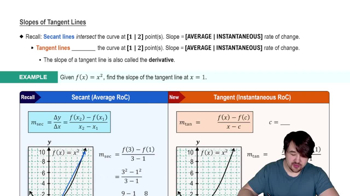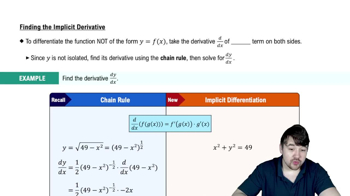Table of contents
- 0. Functions7h 52m
- Introduction to Functions16m
- Piecewise Functions10m
- Properties of Functions9m
- Common Functions1h 8m
- Transformations5m
- Combining Functions27m
- Exponent rules32m
- Exponential Functions28m
- Logarithmic Functions24m
- Properties of Logarithms34m
- Exponential & Logarithmic Equations35m
- Introduction to Trigonometric Functions38m
- Graphs of Trigonometric Functions44m
- Trigonometric Identities47m
- Inverse Trigonometric Functions48m
- 1. Limits and Continuity2h 2m
- 2. Intro to Derivatives1h 33m
- 3. Techniques of Differentiation3h 18m
- 4. Applications of Derivatives2h 38m
- 5. Graphical Applications of Derivatives6h 2m
- 6. Derivatives of Inverse, Exponential, & Logarithmic Functions2h 37m
- 7. Antiderivatives & Indefinite Integrals1h 26m
- 8. Definite Integrals4h 44m
- 9. Graphical Applications of Integrals2h 27m
- 10. Physics Applications of Integrals 2h 22m
4. Applications of Derivatives
Implicit Differentiation
Problem 3.8.84
Textbook Question
Orthogonal trajectories Two curves are orthogonal to each other if their tangent lines are perpendicular at each point of intersection (recall that two lines are perpendicular to each other if their slopes are negative reciprocals). A family of curves forms orthogonal trajectories with another family of curves if each curve in one family is orthogonal to each curve in the other family. For example, the parabolas y = cx² form orthogonal trajectories with the family of ellipses x²+2y² = k, where c and k are constants (see figure).
Find dy/dx for each equation of the following pairs. Use the derivatives to explain why the families of curves form orthogonal trajectories. <IMAGE>
y = cx²; x²+2y² = k, where c and k are constants
 Verified step by step guidance
Verified step by step guidance1
Step 1: Start by finding the derivative of the first family of curves, y = cx². Differentiate both sides with respect to x to find dy/dx. This will give you the slope of the tangent line to the parabola at any point.
Step 2: Differentiate the equation of the second family of curves, x² + 2y² = k, implicitly with respect to x. This involves using the chain rule for the term 2y², as y is a function of x.
Step 3: Solve the implicit differentiation from Step 2 for dy/dx. This will give you the slope of the tangent line to the ellipse at any point.
Step 4: Compare the expressions for dy/dx obtained from both families of curves. For the curves to be orthogonal trajectories, the product of their slopes (dy/dx from each family) at any point of intersection should be -1, indicating that the slopes are negative reciprocals.
Step 5: Verify that the product of the slopes from Step 1 and Step 3 is indeed -1. This confirms that the families of curves are orthogonal trajectories, as their tangent lines are perpendicular at each point of intersection.
 Verified video answer for a similar problem:
Verified video answer for a similar problem:This video solution was recommended by our tutors as helpful for the problem above
Video duration:
3mPlay a video:
Was this helpful?
Key Concepts
Here are the essential concepts you must grasp in order to answer the question correctly.
Orthogonal Trajectories
Orthogonal trajectories are pairs of curves that intersect at right angles. This means that at each point of intersection, the slopes of the tangent lines to the curves are negative reciprocals of each other. For example, if one curve has a slope of m, the other must have a slope of -1/m. This concept is crucial for understanding how different families of curves relate to each other geometrically.
Derivatives and Slopes
The derivative of a function at a given point represents the slope of the tangent line to the curve at that point. In the context of orthogonal trajectories, calculating the derivatives of the given curves allows us to determine their slopes at points of intersection. By showing that these slopes are negative reciprocals, we can confirm that the curves are indeed orthogonal to each other.
Recommended video:

Slopes of Tangent Lines
Families of Curves
A family of curves refers to a set of curves defined by a common equation that includes one or more parameters. For instance, the parabolas defined by y = cx² form a family where 'c' varies. Similarly, the ellipses defined by x² + 2y² = k form another family. Understanding how these families interact, particularly in terms of orthogonality, is essential for solving problems involving their relationships.
Recommended video:

Summary of Curve Sketching

 5:14m
5:14mWatch next
Master Finding The Implicit Derivative with a bite sized video explanation from Nick
Start learningRelated Videos
Related Practice



